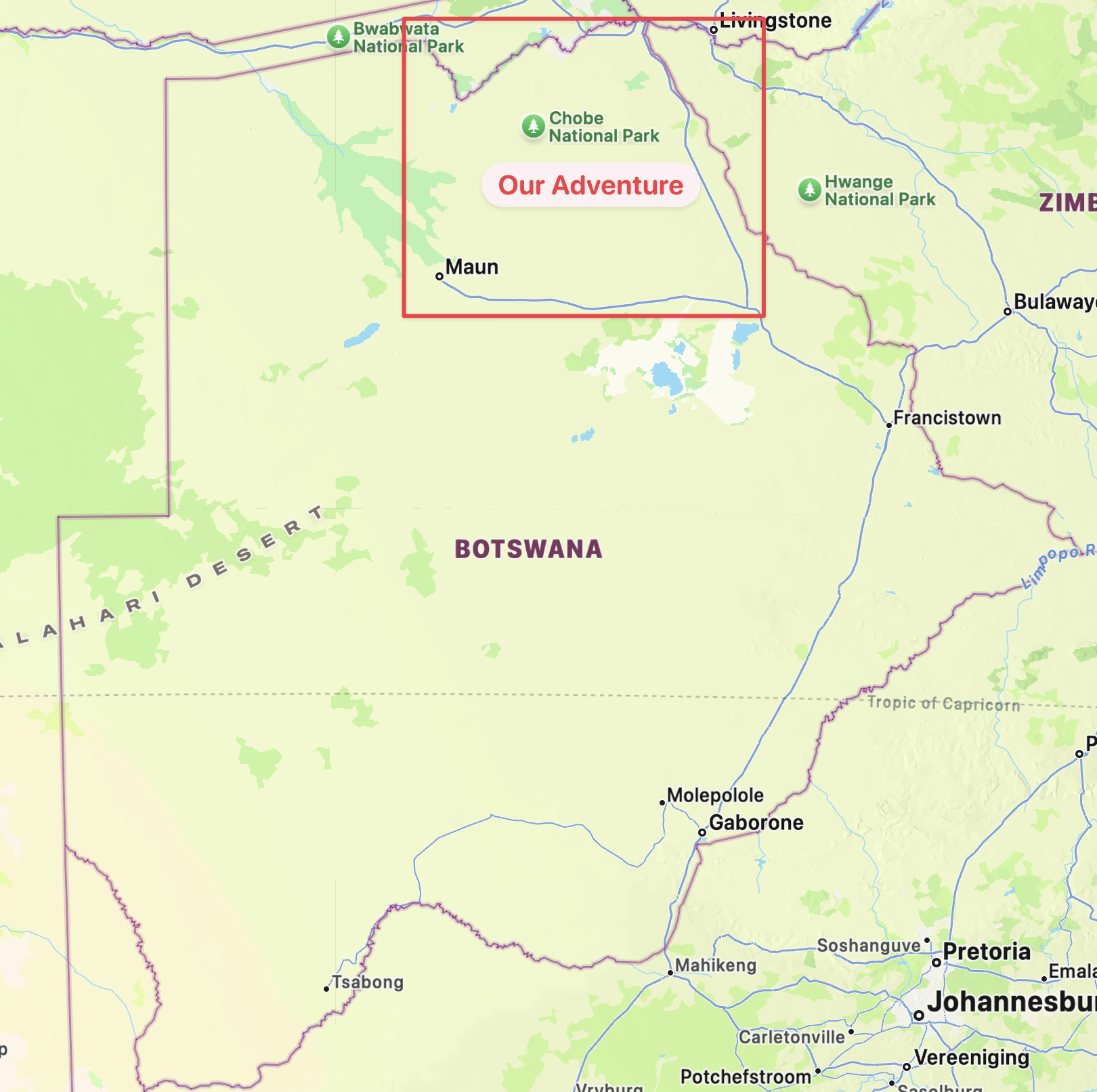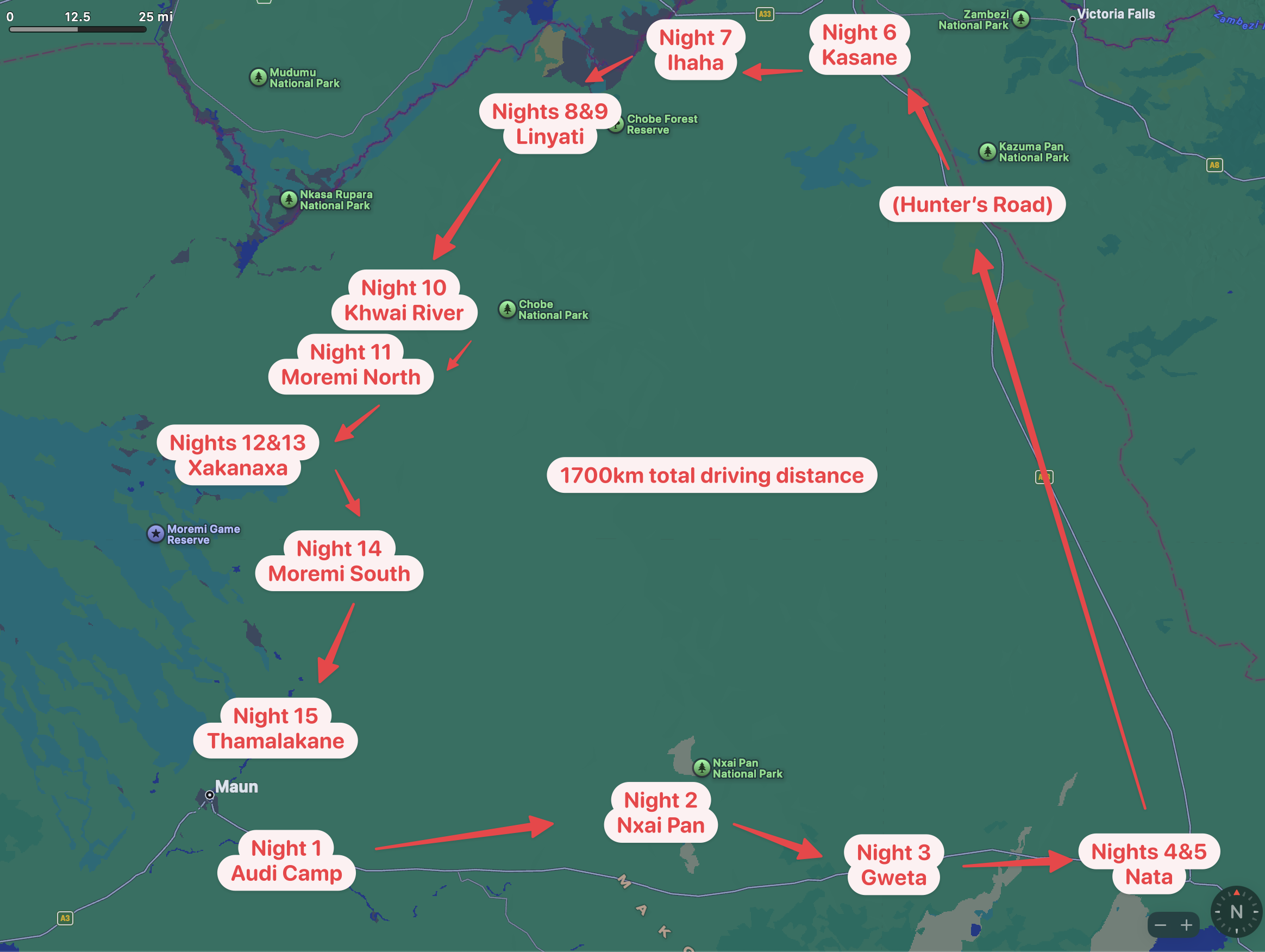Self Driving in Botswana
We had an amazing adventure driving ourselves around the northeast corner of Botswana in two 4x4 Land Cruisers.
 Zoomed out map view
Zoomed out map view
The term “self drive” is an interesting one; elsewhere you would just say “rent a vehicle”. So much of Botswana is wild, meaning you see elephants, ostrich, giraffe, and even the big cats just about everywhere but the cities. Even in the middle of Kasane we saw warthogs roaming the town, and baboons playing and fighting along the Spar grocery store roofs. So the significance of “self drive” is that you are driving yourself into the wild, without a guide, and probably camping. So certain precautions are in order.
Botswana and neighboring Namibia are two of the most sparsely populated countries in the world. Botswana is big (almost as big as France) and our journeys covered only the northeast quadrant of the country.
 Self-driving itinerary
Self-driving itinerary
Ken did all the heavy lifting for us, arranging not just the rentals from Bushlore but also coordinating our itinerary. None of us had any idea of what to expect: roads, camping, danger, etc. We really just showed up and dove in, but it was nice knowing that we had a planned itinerary with lodging setup for the entire two weeks. With Ken’s guidance Bushlore took care of the reservations. While we could have done this on our own, given how many different vendors there were to work with it was nice having this taken care of.
Our total drive distance was 1700km, with some of it being fast and on the highway (Maun to Gweta to Nata to Kasane) but most of our time being spent in very slow-going sandy terrain.
The Vehicles
Our vehicles were Toyota Land Cruiser 70 series, heavy duty and diesel, with steering wheel on the right so manual shifting with the left hand. The other option from Bushlore was the Toyota Hilux, a pickup frame that would probably have been fine for us but we needed two tents on one of the vehicles so the larger Land Cruiser was the better option.
I forgot to check what the model year was for the vehicle, but I suspect it was just two or three years old. Both had the computer panels, and one even had working Apple CarPlay for the first half of the trip. It stopped working around Kasane; I suspect dust and dirt as interfering with the USB connection.
We loved driving these vehicles! All five of us took turns, and everyone took to the oppo manual transmission quickly. They were easy to move from 2WD to 4WD and 4WD low, but more challenging to take back from 4WD to 2WD. These Land Cruisers have automatic / computer controlled locking differentials that we never had to use.
Off-road Driving and Recovery
The primary terrain challenge we faced was deep sand. Lots of it. Sometimes for the entire day of driving, such as the day we spent 8 hours driving 100km (Linyati to Khwai Safari Grounds). Our first line of defense to navigate the sand was to air down the tires. The recommend tire pressure for the tar (paved) roads was 3 bar (43.5 psi). After some discussion with our checkout team at Bushlore, it was agreed that 2.5 bar (36.25 psi) was a good neutral setting that would work on the tar roads and some lighter sand, so that was our normal setting when we left the sand. On the sand we would go to 2 bar (29 psi), which worked fine. This is even a bit higher than Julie and I usually go to with our van (20-25 psi), though the Bushlore rep did say we could go down as far as 1.75 bar (25 psi). Turns out 2 bar was fine for us.
We would also need to go into 4WD, and if things got very deep we would engage 4WD low. We mostly lived in 2nd gear in these vehicles; you could almost start in this gear and you could certainly let the vehicle slow to a crawl then go back up to 20 km/hr or so. This meant you didn’t have to spend a lot of time and energy shifting.
Each vehicle also did about 5 stream crossings, and we always went into 4WD low and crossed in 2nd gear.
We only had one required recovery: Kelin and I swamped our Land Cruiser (I happened to be riding with her that day) in some very deep sand and the 4WD low alone was not enough to free us. We had a few options: bring out the sand tracks, use the Hi-Lift Jack to raise one corner and dig us out, or use the other vehicle to pull us out of our quandary. The last option was the easiest, and the reason we wanted to have two vehicles for the journey was to make recovery easier.
Our first attempt was to use the winch in the second vehicle (which was behind the stuck vehicle). Sadly, the winch cable was all fouled up on the spool and we couldn’t get it out. We had tested the other winch cable but after 3 hours of orientation we moved too quickly on checking out the second vehicle. Regrets.
Instead we attached a recovery tow cable between the two vehicles, then used the reverse 4WD low gear (along with reversing the other vehicle) to work our way out of the hole. It worked great.
Fuel
Fuel was not expensive in Botswana, and we filled at just about every opportunity. We also carried three 5 gallon jerrycans each, one more than Bushlore recommended. We liked having the extra margin, and I’m glad Ken suggested this.
The big challenge is once you are up in the Chobe and Moremi area. Historically the final fuel option has been Kasane, but recently a Shell station with diesel opened up in Ngoma Bridge which you encounter as you transition from Chobe to Moremi. Even with this extra stop we still kept a close eye on fuel. We were never in danger of running out, and ended the journey with nearly a half tank (after emptying the jerrycans into each vehicle) when we returned to Maun.
Why does the fuel run out so quickly? Two main reasons: the churning off-road driving in the sand leads to very low mileage rates, and the extensive amount of game driving that is common on a trip like this. We weren’t just driving to get to our next destination; we were always driving around the area looking for wildlife.
Problems with the vehicles
Most everything worked great with the vehicles, especially with the drive train, but there were a few issues. I’ll talk about the camping experience in a different post, so here I’ll just focus on the driving experience.
I already mentioned the issue with the winch on one of the vehicles. The air conditioning was also a challenge. In “our” vehicle (Julie, Karen, and mine) the A/C was average at best, but was consistently so. Ken and Kelin’s A/C was mostly non-existent for the first half of the trip. The weather had cooled off a bit at the start of our journey so this wasn’t a huge deal, but as we got to Kasane and Chobe it was heating up again. Fortunately Bushlore has a facility in Kasane and they were able to fix this problem (replacing the fan).
Another item that we failed to check in the second Land Cruiser was the air compressor. Not only did ours not work, it was missing the air hose. We were able to use the other (slowing us down), then swapped in a new unit during the visit to Kasane.
Bushlore says this on their website:
Ideal for 4 travellers. Highly respected safari vehicle in Africa, with no electronics and ideal for remote travel.
No electronics, huh? That’s utter bullshit, though I suspect they mean no computer-controlled drive train. There are electronics running the computer console, there’s a remote locking system which I highly doubt is purely analog, and there’s a security system. Both vehicles had odd, random triggering of the security alarm. We couldn’t figure out why it would happen, with the only good news being that the horns largely didn’t work.
Navigation and Communication
Bushlore offers some add-ons that we took advantage of: a satellite phone for emergencies, two-way radios, and a GPS navigation system with Tracks4Africa pre-loaded. We never needed the sat phone, and with our handy Starlink mini I can’t imagine ever needing it (we didn’t know we would bring a Starlink when we first made our bookings). The GPS units and radios were nearly worthless.
The radios… oh the radios. They had a range of maybe 100 meters. We wish we had just brought our own.
The GPS units were old-style Garmin units with horrible touch screens. They required full-time use of the 12v cigarette lighter power source, which was going to be a show-stopper for us (without some form of daisy chain adapter). Plus, the Land Cruisers had built-in navigation and Tracks4Africa already installed in the computer console! This would be a good thing for Bushlore to disclose. The GPS units lived in our glove boxes for the duration of the trip.
We rarely used Tracks4Africa to navigate: Gaia GPS was so much better. I’ve been using Gaia for several years here in the states (and Spain, and Morocco) and it was so much better than Tracks4Africa. We didn’t use it for point to point route finding, but would instead just use it with another human as a navigation assist. We were shocked that most of the roads were in Gaia, and even when we wandered into areas where Gaia didn’t have roads we could still use the app to find our way back to a main route safely.
It goes without saying that these tools (Google Maps as well, as we used that when navigating the highways and in the few towns we visited) that you need to download the layers for offline use. Gaia makes this very easy.
Even though I’ve been hard on Bushlore in this post, I think we would still go back to them for a future trip. The vehicles more than lived up to their intended purpose, kept us safe, and the issues I mention are all fairly minor and avoidable for a future trip.
To wrap this up, here’s a video with some highlights of our driving adventures.
